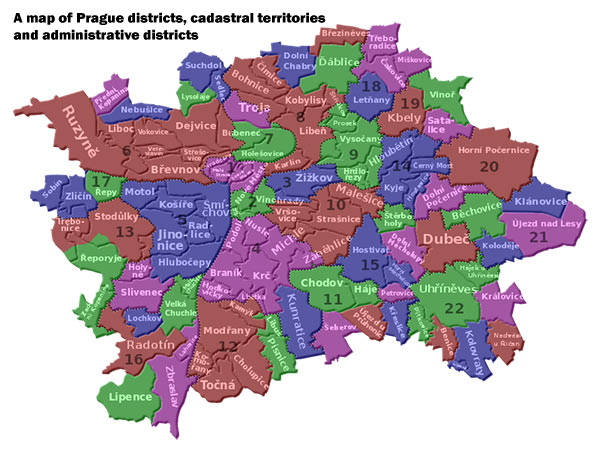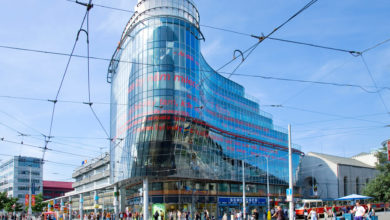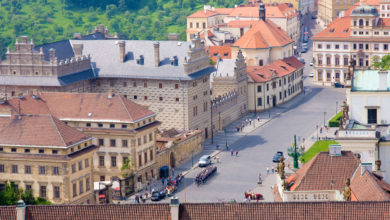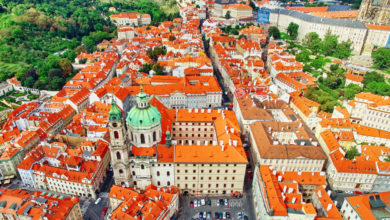Administration and Structure of the City of Prague

Prague City Hall is the local and regional authority of the capital city of Prague. The Law defines its scope on the City of Prague and the city ordinance on the Statute of the City of Prague. The activities and organizational structure of the municipality are regulated by rules issued by Prague City Council Resolution. The municipality performs the tasks assigned by the local authority or the city council and exercises delegated state powers of the capital city. Some independent and delegated powers of the city of Prague are delegated by city status to municipal districts. In the exercise of delegated powers, the municipality takes precedence over municipal districts, governing the exercise of their jurisdiction and reviewing their decisions. Prague City Hall employs around 1800 people.
The municipality operates in many buildings in different locations in Prague, and its headquarters is the New Town Hall at Marienplatz in the Old Town. The second important building is Skoda Palace at Jungmann Street in New Town, leased to the municipality.
In the lower-quality media, and sometimes colloquially, the municipality is incorrectly referred to as Prague City Assembly or other elected city authorities (e.g. Prague City Council) to distinguish it from municipal districts.
The Position of Prague in the Czech Republic
Prague is the capital of the Czech Republic, and as such, is the regular seat of its central authorities. Additionally, since the 24th November 1990, it is, in fact, a re-statutory town, but has a special status of municipalities and regions at the same time. Prague is not subject to the Municipalities Act (No. 128/2000 Coll.) and the Regions Act (No. 129/2000 Coll.). However, a special Law on the City of Prague (No. 131/2000 Coll.) applies. This law refers to its status, but Prague itself is not included in the statutory cities. Prague issues for its territory its own laws, decrees and regulations, which are published in the Collection of Laws of the City of Prague. In Prague, there is also the seat of the administrative institution of the Central Region.
Cadastral Division
Cadastral Territory of the Capital City of Prague
By 1949, the administrative districts, except 1947, were composed of one or more whole cadastral units, the former villages or cities. Since 1949 there has been a fundamental change in the administrative structure. Since then, the borders of many city districts, administrative districts and boroughs are independent of the borders of cadastral areas. Some cadastral areas are thus divided into several administrative and self-governing city districts. Cadastral areas (for example, Vinohrady and Smíchov) are still relevant, especially for land and property registration and labelling buildings. Prague is composed of 112 cadastral areas of different size, character and importance.
Significant Districts
City centre: Old Town, New Town, Josefov, Lesser Town, Prague Castle, Vyšehrad
Great districts near the city centre: Smíchov, Vinohrady, Nusle, Vršovice, Žižkov, Karlín, Libeň, Vysočany, Holešovice, Bubeneč, Dejvice, Braník
Regional Division
In 1960, ten districts were established, and these districts expanded to newly affiliated municipalities and paid the country according to the Law on Territorial Division. These districts were originally administrative and self-governing districts. Residents of most of the districts were liable directly to the District National Committee (later the District Office). Still, in later connected communities, they remained as an intermediate of local, national committees (local authorities), which also fall within the powers of the appropriate district. Since 1990, however, these districts are not self-governing district units, and since 2001 they have not had territorial-administrative districts either. Today, just courts, post offices or various administrative companies are organized according to them.
A list of the ten districts under Act No. 36/1960 Coll. Each district has its own city district that now forms the territory of the district:
Praha 1: Praha 1
Praha 2: Praha 2
Praha 3: Praha 3
Praha 4: Praha 4, Praha-Kunratice, Praha 11, Praha-Újezd, Praha-Šeberov, Praha 12, Praha-Libuš
Praha 5: Praha 5, Praha-Slivenec, Praha 13, Praha-Řeporyje, Praha 16, Praha-Velká Chuchle, Praha-Lochkov, Praha-Lipence, Praha-Zbraslav, Praha-Zličín
Praha 6: Praha 6, Praha-Lysolaje, Praha-Nebušice, Praha-Přední Kopanina, Praha 17, Praha-Suchdol
Praha 7: Praha 7, Praha-Troja
Praha 8: Praha 8, Praha-Březiněves, Praha-Dolní Chabry, Praha-Ďáblice
Praha 9: Praha 9, Praha 14, Praha-Dolní Počernice, Praha 18, Praha 19, Praha-Vinoř, Praha-Satalice, Praha-Čakovice, Praha 20, Praha 21, Praha-Klánovice, Praha-Koloděje, Praha-Běchovice
Praha 10: Praha 10, Praha-Křeslice, Praha 15, Praha-Dolní Měcholupy, Praha-Štěrboholy, Praha-Petrovice, Praha-Dubeč, Praha 22, Praha-Královice, Praha-Nedvězí, Praha-Kolovraty, Praha-Benice
The Administrative and Self-governing Division
Prague has 57 self-governing city districts managed by an elected local authority and a council, the mayor, and the district office. Since the establishment of city districts, the authorities of some city districts were entrusted with some of the powers of government, even for other city districts.
Since 1 July 2001, this level of competence has been divided into 22 administrative districts in the whole of Prague. If there is in maps or the text connected with Prague a reference to “administrative district”, it most commonly means the administrative district of these powers and levels. Since 1 January 2002, the name of these 22 city districts is the word Prague with the corresponding number, and the same name is used for the administrative district of its expanded powers. Some of these 22 city districts have these powers only for their territory; others have these powers even for other city districts.
However, the territory of most of the 22 administrative districts (all except for Prague 1-3) is not identical to the territorial districts according to the Law on Territorial Division, which existed originally (before 1990), as well as administrative districts and had their own corps (ONV). The government and the deputies repeatedly come up with proposals to abolish the old division.






